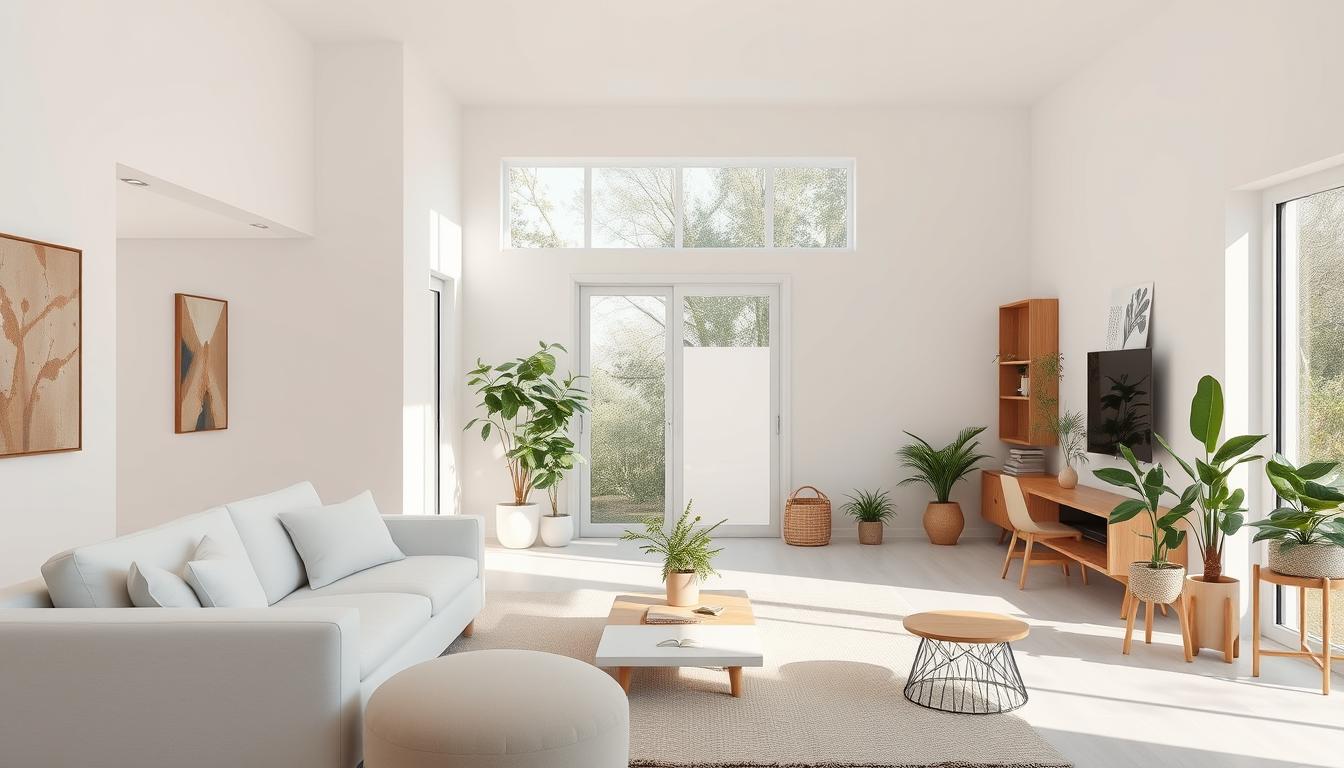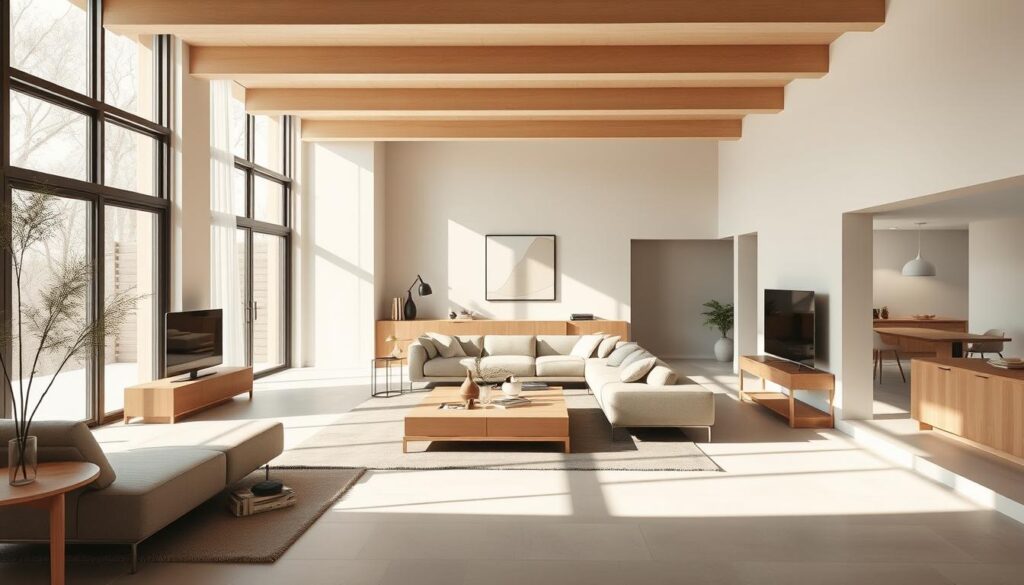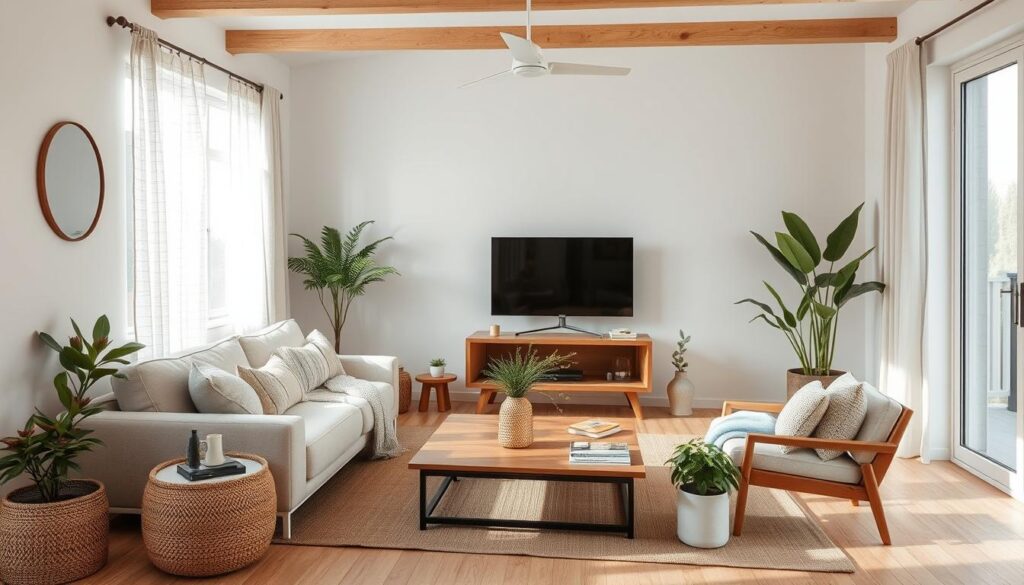In the ever-evolving landscape of modern living, the allure of minimalism has captivated the minds of individuals seeking a harmonious and intentional approach to their homes. As we step into the year 2025, the desire for a serene and decluttered living space has become increasingly paramount. Minimalist living offers a transformative path, empowering individuals to cultivate a sense of clarity, tranquility, and well-being within the confines of their personal sanctuaries.

In this article, we will delve into the principles and practices of minimalist living, exploring how to create a serene home that aligns with the demands and aspirations of the 21st century. From understanding the philosophy behind minimalism to implementing practical strategies for decluttering and optimizing your living space, this comprehensive guide will equip you with the necessary tools to embrace a lifestyle that prioritizes simplicity, functionality, and a profound sense of calm.
As we navigate the ever-evolving landscape of modern living, the allure of minimalism has become increasingly captivating. Embracing a minimalist approach to our homes allows us to transcend the clutter and distractions that often plague our daily lives, enabling us to cultivate a sense of serenity and intentionality within our personal sanctuaries. In the years ahead, the pursuit of minimalist living will only grow in relevance, as individuals seek to create harmonious and decluttered environments that nourish their well-being and support their aspirations.
Understanding the Essence of Modern Minimalism
In the fast-paced world of 2025, the philosophy of modern minimalism has gained significant traction. At its core, minimalist living is about embracing simplicity, functionality, and intentionality in our daily lives. This approach to life and design is rooted in a deep understanding of the minimalist philosophy, which has evolved over time.
The Philosophy Behind Minimalist Living
The minimalist philosophy emphasizes the idea that less is more. It encourages individuals to focus on the essential elements of their lives, discarding the unnecessary clutter and distractions that can often weigh us down. This philosophy promotes a sense of clarity, tranquility, and mindfulness, allowing individuals to live more harmonious and fulfilling lives.
Historical Evolution of Minimalism
- The roots of modern minimalism can be traced back to the early 20th century, with movements like the Bauhaus school and the modernist architecture movement.
- In the mid-20th century, minimalist art and design gained prominence, with artists and designers like Donald Judd, Dan Flavin, and Ludwig Mies van der Rohe leading the charge.
- Over the years, the minimalist philosophy has evolved, adapting to the changing needs and societal trends of each era, culminating in the rise of modern minimalism in the 21st century.
Why Minimalism Matters in 2025
In the fast-paced, hyper-connected world of 2025, modern minimalism offers a much-needed antidote to the overwhelming clutter and digital distractions that often characterize modern life. By embracing the principles of minimalist living, individuals can create a sense of calm, focus, and well-being, ultimately leading to a more fulfilling and sustainable lifestyle.
The Psychology of Clutter and Its Impact on Mental Well-being
In today’s fast-paced world, the impact of clutter on our mental well-being is a topic of growing concern. Numerous studies have shown that the presence of physical clutter can have a significant impact on our cognitive function, emotional state, and overall stress levels.
Clutter psychology, a field that examines the relationship between our surroundings and our mental health, has revealed some fascinating insights. Research indicates that living in a cluttered environment can lead to increased feelings of anxiety, depression, and even reduced productivity. The visual stimuli created by excessive belongings can overwhelm the senses, making it difficult to focus and process information effectively.
Moreover, clutter has been linked to higher levels of the stress hormone cortisol. Chronic exposure to this hormone can have detrimental effects on both physical and mental well-being, contributing to issues such as insomnia, high blood pressure, and burnout. By decluttering and creating a more organized, minimalist living space, individuals can experience a noticeable reduction in stress and an improved sense of mental well-being.
Embracing a minimalist lifestyle and understanding the psychology of clutter can be a powerful tool in promoting mental health and overall quality of life. As we navigate the challenges of the modern world, incorporating these principles into our homes and daily routines can be a transformative step towards a more serene and balanced existence.
| Clutter Psychology | Impact on Mental Well-being |
|---|---|
| Cognitive Overload | Increased Anxiety and Depression |
| Elevated Stress Levels | Reduced Productivity and Focus |
| Visual Stimuli Overwhelm | Insomnia and High Blood Pressure |
By understanding the psychological impact of clutter and taking steps to create a more organized, minimalist living space, individuals can experience a significant improvement in their mental well-being and overall quality of life.
Essential Principles of Creating a Serene Living Space
Designing a serene and minimalist living space is not just about decluttering and stripping away the excess. It involves carefully crafting a balanced, harmonious environment that promotes a sense of tranquility and well-being. By embracing the core principles of minimalist design, you can transform your home into a serene living space that nourishes the mind and soul.
Balance and Harmony in Design
Achieving balance and harmony in your minimalist design principles is crucial for creating a calming atmosphere. Symmetry, proportion, and the strategic placement of furnishings and decor can all contribute to a sense of equilibrium. Incorporate clean lines, neutral tones, and minimal patterns to establish a soothing aesthetic that invites relaxation.
The Role of Natural Light
The strategic use of natural light can significantly enhance the serenity of a minimalist space. Maximize the influx of natural light by positioning furniture and window treatments to allow for an unobstructed flow of sunlight. This not only brightens the room but also creates a warm, inviting ambiance that can uplift the senses.
Color Psychology in Minimalist Spaces
The color palette you choose for your minimalist living space can have a profound impact on the overall mood and atmosphere. Soft, muted tones like shades of white, gray, and beige can evoke a sense of calmness and tranquility. Incorporate pops of natural hues, such as soft blues or greens, to add depth and balance without overwhelming the senses.
Decluttering Strategies for the Modern Home
In the pursuit of a minimalist lifestyle, decluttering your home is a crucial step. Embracing decluttering techniques can transform your living space, fostering a sense of serenity and clarity. From tackling the most cluttered areas to maintaining a clutter-free environment, this section offers practical strategies to help you achieve a minimalist home organization.
Assess and Prioritize
Begin by evaluating your belongings, room by room. Identify the items you truly need and use, and be honest about what can be let go. Categorize your possessions into keep, donate, and discard piles. This process allows you to prioritize what’s essential and create a more harmonious living environment.
The Art of Letting Go
Decluttering can be an emotional journey, but it’s essential to approach it with an open mind and a commitment to a minimalist lifestyle. Challenge yourself to let go of items that no longer serve a purpose or bring joy to your life. Embrace the liberating feeling of simplifying your surroundings.
Maintain a Clutter-Free Space
- Implement a “one-in, one-out” policy: for every new item you bring into your home, thoughtfully remove an existing one.
- Regularly review and purge your belongings to prevent the accumulation of clutter.
- Invest in smart storage solutions that maximize space and keep your home organized.
By incorporating these decluttering strategies into your daily routine, you can achieve a serene, minimalist home that reflects your values and enhances your overall well-being.
| Decluttering Technique | Benefits |
|---|---|
| Categorize and Prioritize | Helps identify essential items and let go of what no longer serves a purpose |
| Implement a “One-In, One-Out” Policy | Prevents the accumulation of new clutter and maintains a minimalist lifestyle |
| Utilize Smart Storage Solutions | Maximizes space and keeps the home organized and visually appealing |
Minimalist Living: How to Create a Serene Home in 2025
As we look towards the future, the concept of minimalist living continues to evolve, offering a refreshing approach to creating a serene and harmonious home environment. In 2025, the trends and innovations in minimalist living are poised to transform the way we design and experience our living spaces.
Current Trends and Innovations
The minimalist movement is gaining momentum, with a growing emphasis on intentional, clutter-free spaces that promote well-being and mindfulness. Emerging design trends in 2025 include the integration of 2025 minimalism trends such as multifunctional furniture, reclaimed materials, and a focus on natural textures and earthy color palettes.
Technology Integration in Minimalist Spaces
The rise of smart home technology is seamlessly merging with the principles of minimalism, creating highly efficient and automated living spaces. From voice-controlled lighting and climate systems to seamless home appliance integration, the minimalist home of 2025 will be a testament to the power of technology to streamline and enhance our daily lives.
Sustainable Approaches to Minimalism
Sustainability has become a driving force in the minimalist movement, and in 2025, we’ll see a growing emphasis on sustainable living practices. This includes the use of eco-friendly materials, energy-efficient appliances, and a focus on circular design, where products are designed for longevity and repurposing.
As the world embraces the benefits of minimalist living, the homes of 2025 will be a testament to the power of simplicity, technology, and sustainability to create truly serene and harmonious living spaces.
Smart Storage Solutions for Clutter-Free Living
In the pursuit of minimalist living, smart storage solutions play a crucial role in creating a serene and clutter-free home. From multi-functional furniture to hidden organizational tools, the modern minimalist has access to a wide array of innovative options to streamline their living space.
One of the primary keys to a successful minimalist lifestyle is the ability to maximize space and seamlessly integrate storage into the overall design. Transformative furniture, such as ottomans with built-in compartments or beds with under-the-bed drawers, offer discreet and practical storage solutions that preserve the clean, uncluttered aesthetic.
For those seeking even more customized storage, modular shelving systems and wall-mounted organizational tools can be tailored to specific needs. These space-saving solutions allow homeowners to create efficient storage for everything from books and office supplies to kitchen essentials, all while maintaining a harmonious, minimalist ambiance.
In addition to physical storage, the modern minimalist must also consider digital clutter. Cloud-based storage and document management systems can help minimize the physical footprint of paperwork and electronic devices, further enhancing the sense of serenity and focus within the home.
| Storage Solution | Benefit | Example |
|---|---|---|
| Multi-functional Furniture | Discreet, space-saving storage | Ottoman with hidden compartments |
| Modular Shelving Systems | Customizable, adaptable storage | Wall-mounted shelves with adjustable compartments |
| Cloud-based Storage | Minimizes physical clutter | Digital document management platforms |
By incorporating these innovative smart storage solutions, minimalist enthusiasts can streamline their living spaces and cultivate a serene, clutter-free environment that aligns with their organizational tools and lifestyle preferences.
The Art of Choosing Quality Over Quantity
In the realm of minimalist living, the principle of quality over quantity reigns supreme. As we strive to create serene and sustainable homes, it’s essential to prioritize durable, timeless pieces that will stand the test of time. This strategic approach not only aligns with the minimalist philosophy but also promotes sustainable consumption, reducing waste and environmental impact.
Investment Pieces for Longevity
Investing in high-quality, well-crafted investment pieces is a cornerstone of minimalist living. These furniture and decor items are designed to withstand the rigors of everyday use while maintaining their aesthetic appeal for years to come. By carefully selecting these timeless treasures, you can build a cohesive, harmonious living space that exudes a sense of tranquility and permanence.
Sustainable Materials and Choices
Alongside the pursuit of quality, minimalist living also emphasizes the importance of sustainable materials and choices. From eco-friendly fabrics and natural fibers to responsibly sourced wood and recycled materials, the modern minimalist consumer is increasingly conscious of their environmental footprint. By making mindful selections, you can create a serene space that not only reflects your values but also contributes to a more sustainable future.
By embracing the art of choosing quality over quantity, you’ll not only cultivate a visually stunning and harmonious living environment but also make a meaningful impact on the world around you. This holistic approach to minimalist living ensures that your home remains a tranquil oasis for years to come.
Creating Functional Minimalist Zones in Your Home
As you embrace the principles of minimalist living, designing functional zones within your home becomes crucial. By strategically organizing your space, you can maximize efficiency and maintain a serene atmosphere, allowing you to truly enjoy the beauty of minimalist design.
Start by identifying the primary activities that take place in your home. Whether it’s a cozy reading nook, a productive home office, or a relaxing sanctuary for self-care, each zone should serve a specific purpose. By defining these functional areas, you can allocate resources and furniture thoughtfully, ensuring that every inch of your minimalist home is utilized to its fullest potential.
When it comes to space optimization, consider multi-purpose furniture and storage solutions that seamlessly integrate into your minimalist aesthetic. Modular shelving units, convertible furniture, and hidden storage can help you maintain a clutter-free, minimalist home zones while accommodating your daily needs.

To enhance the functional design of your home, pay close attention to the flow of movement and natural light. Strategically placing key furniture and accessories can create a sense of harmony and balance, allowing you to navigate your living spaces with ease and inspiration.
Remember, the essence of minimalist living is not just about the absence of clutter, but about creating a serene and intentional environment that nurtures your well-being. By mastering the art of space optimization, you can transform your home into a haven of tranquility and functionality, truly embodying the spirit of minimalist design in 2025 and beyond.
Incorporating Natural Elements for Serenity
In the pursuit of creating a minimalist yet serene living space, the integration of natural elements plays a crucial role. By embracing the principles of biophilic design, homeowners can harness the restorative power of nature and foster a harmonious, calming atmosphere within their abodes.
Biophilic Design Elements
Biophilic design is a holistic approach that seeks to reconnect individuals with the natural world, even in urban and indoor environments. Some key biophilic design elements that can be incorporated into minimalist interiors include:
- Abundant indoor plants and living walls
- Natural lighting through large windows or skylights
- Natural textures and materials, such as wood, stone, and natural fibers
- Incorporation of natural shapes and patterns in furnishings and decor
- Soothing water features, such as small fountains or aquariums
Sustainable Plant Selection
When selecting indoor plants to enhance the serenity of a minimalist space, it’s important to consider their sustainability and low-maintenance requirements. Some ideal options include:
- Succulents, such as jade plants or aloe vera, which thrive in minimal watering
- Air plants, which require no soil and can be creatively displayed
- Bamboo, a fast-growing and resilient plant that adds a natural touch
- Pothos or philodendrons, which are hardy and adapt well to diverse environments
By thoughtfully incorporating these natural elements in decor, homeowners can create a tranquil and rejuvenating sanctuary that embodies the essence of minimalist living.
Digital Minimalism: Managing Virtual Clutter
In the digital age, the concept of minimalism extends beyond physical possessions to our virtual spaces. Digital clutter can be just as overwhelming as tangible clutter, impacting our productivity, focus, and overall well-being. As we navigate the demands of modern life, it’s crucial to adopt digital decluttering strategies to create a harmonious tech-life balance.
One of the primary steps in virtual organization is to take control of our digital footprint. This includes streamlining our email inboxes, curating social media feeds, and organizing our computer files and cloud storage. By decluttering these virtual spaces, we can reduce distractions and regain a sense of clarity in our digital lives.
- Implement a ruthless email management system: Unsubscribe from unnecessary mailing lists, create folders for sorting messages, and set up filters to automatically route important emails to designated folders.
- Curate your social media: Unfollow accounts that no longer align with your interests or values, and consider limiting your time on social platforms to reduce mindless scrolling.
- Organize digital files: Develop a file-naming convention and a logical folder structure to keep your documents, photos, and other digital assets neatly organized.
Beyond managing our virtual spaces, it’s equally important to establish healthy tech-life balance habits. This may involve setting boundaries around screen time, implementing digital detox practices, and finding ways to integrate more offline activities into our daily routines.
| Strategies for Tech-Life Balance | Benefits |
|---|---|
| Scheduled device-free time | Improved focus, reduced stress, and increased productivity |
| Regular digital detoxes | Enhanced mental well-being and renewed appreciation for offline experiences |
| Mindful technology use | Greater self-awareness and intentionality in digital engagement |
By embracing digital minimalism, we can reclaim our time, reduce stress, and cultivate a more harmonious and fulfilling relationship with technology. Through a thoughtful approach to virtual organization and tech-life balance, we can create a serene and focused digital environment that supports our overall well-being.
Maintaining a Minimalist Lifestyle Long-term
Embracing a minimalist lifestyle is not just a passing trend – it’s a transformative way of living that can bring lasting peace and serenity to your home. To ensure that your minimalist journey remains sustainable, it’s crucial to establish minimalist habits and regularly assess your possessions and spaces.
Building Sustainable Habits
Transitioning to a minimalist lifestyle requires discipline and consistency. Start by incorporating these minimalist habits into your daily routine:
- Practice regular decluttering sessions, whether weekly or monthly, to maintain a clutter-free environment.
- Adopt a mindful approach to acquiring new items, asking yourself if each purchase aligns with your minimalist values.
- Develop a system for managing digital clutter, such as regularly clearing your inbox and organizing digital files.
- Incorporate relaxation practices, such as meditation or mindfulness exercises, to reinforce the calming effects of your minimalist space.
Regular Assessment Strategies
Maintaining a minimalist lifestyle long-term also requires periodic lifestyle maintenance and regular decluttering of your possessions and living spaces. Consider implementing these strategies:
- Schedule quarterly or biannual reviews of your belongings, evaluating what you truly need and use.
- Explore innovative storage solutions to keep your home organized and clutter-free.
- Regularly assess the functionality and aesthetic harmony of your minimalist spaces, making adjustments as needed.
- Celebrate your progress and find ways to share your minimalist journey with others, inspiring them to embrace a more serene and intentional lifestyle.
By building sustainable minimalist habits and implementing regular lifestyle maintenance and decluttering strategies, you can ensure that your minimalist lifestyle remains a source of long-term fulfillment and serenity in your home.
Budget-Friendly Approaches to Minimalist Design
Achieving a minimalist aesthetic doesn’t have to break the bank. There are plenty of affordable and budget-friendly ways to incorporate affordable minimalism into your home. From thrifting and upcycling to DIY minimalist projects, you can create a serene, clutter-free space without sacrificing style.
One of the keys to budget-friendly decor is to focus on quality over quantity. Invest in timeless, versatile pieces that can be used in multiple ways, rather than impulse purchases that may quickly lose their appeal. Scour thrift stores, estate sales, and online marketplaces for unique finds that align with your minimalist vision.
If you’re feeling crafty, DIY minimalist projects can be a fun and cost-effective way to personalize your space. From simple wall art to handcrafted furniture, there are endless possibilities for creating custom pieces that reflect your minimalist aesthetic.
- Upcycle old furniture with a fresh coat of paint or new hardware
- Create minimalist wall hangings using found materials or basic woodworking
- Repurpose everyday items into functional decor, like using mason jars as vases
By embracing a budget-friendly approach to minimalism, you can transform your living space into a serene, harmonious haven without breaking the bank. With a little creativity and a keen eye for quality, you can achieve the minimalist look you desire while staying true to your financial goals.

The Impact of Minimalism on Family Life
As the minimalist lifestyle continues to gain momentum, its influence extends beyond individual living spaces to encompass the dynamics of family life. Minimalism offers families a refreshing approach to creating serene and functional shared, fostering a sense of calm and well-being amidst the hustle and bustle of modern family life.
For families with children, the principles of family minimalism can be particularly transformative. By embracing a minimalist parenting mindset, parents can cultivate an environment that encourages focus, creativity, and quality time together. The elimination of clutter and the intentional curation of possessions can lead to increased organization, reduced stress, and more meaningful interactions within the household.
| Benefits of Minimalism for Families | Challenges of Minimalist Living with Children |
|---|---|
|
|
By embracing the principles of family minimalism, families can create shared spaces that foster a sense of calm, creativity, and togetherness. Through thoughtful curation, sustainable habits, and a focus on quality over quantity, families can unlock the true benefits of a minimalist lifestyle and cultivate a harmonious and serene home environment.
Seasonal Adjustments for Minimalist Spaces
Maintaining a minimalist lifestyle doesn’t mean sacrificing the joy of seasonal celebrations. In fact, incorporating subtle, thoughtful seasonal decor can enhance the serene ambiance of your minimalist home. The key is to focus on adaptable spaces that can seamlessly transition between the ever-changing seasons.
When it comes to minimalist holiday decorating, less is often more. Opt for natural elements like pinecones, dried flowers, or simple greenery to add a touch of seasonal charm without overwhelming the space. Swap out throw pillows or blankets for cozy, textured fabrics that evoke the current season, and consider incorporating adjustable lighting to create a warm, inviting atmosphere.
Furthermore, designing adaptable spaces that can be easily transformed allows you to seamlessly transition your home throughout the year. Flexible furniture, multipurpose storage solutions, and thoughtfully placed decor pieces can help you effortlessly make seasonal adjustments without disrupting the overall minimalist aesthetic.



